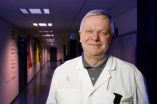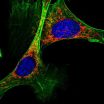(Press-News.org) Numerous studies have linked exposure to bisphenol A (BPA) in plastic, receipt paper, toys, and other products with various health problems from poor growth to cancer, and the FDA has been supporting efforts to find and use alternatives. But are these alternatives safer? Researchers reporting in the Cell Press journal Chemistry & Biology have developed new tests that can classify such compounds' activity with great detail and speed. The advance could offer a fast and cost-effective way to identify safe replacements for BPA.
Millions of tons of BPA and related compounds are produced each year. "I think it is fair to say that many of these BPA analogs have not been thoroughly tested, yet they are used in everyday plastics such as water bottles, baby bottles, and the lining of canned goods." says lead author Dr. Fabio Stossi of Baylor College of Medicine.
BPA and BPA analogs belong to a class of compounds called endocrine disruptors, so named because they can interfere with the body's endocrine, or hormonal, system. Using their newly developed assays on living cells, Dr. Stossi and his colleagues characterized how 18 different BPA analogs affect alpha and beta estrogen receptors, which are the primary targets of this class of chemicals. Their studies were conducted using high throughput microscopy and automated image analysis in different cell line models, with varying exposures to BPA analogs.
The investigators were able to record and analyze massive data sets related to BPA analogs. "The high throughput approach that we've refined during the past several years can simultaneously quantify what these compounds are doing to a wide range of processes such as protein levels, nuclear trafficking, DNA binding, protein interactions, transcription, cell cycle, and proliferation," says senior author Dr. Michael A. Mancini, of Baylor and the Texas A&M Health Science Center Institute of Biosciences and Technology (IBT). "The results showed us that various BPA analogs increased or decreased certain receptor activities, while others were receptor specific; clearly, the various BPA analogs can have unique properties."
The investigators found that many BPA analogs have inhibitory effects on the beta form of the estrogen receptor, a less well-studied steroid receptor that has tumor fighting properties. Many analogs also acted to stimulate the alpha form of the estrogen receptor or they had mixed inhibitory and stimulatory effects. Determining precisely how these effects influence human health will require additional research. "These studies represent a breakthrough in our ability to focus precious resources on those BPA analogs and other endocrine disrupting chemicals of greatest concern," says coauthor Dr. Cheryl Walker of the IBT.
The scientists note that there are likely many more BPA-like compounds that can be found in products and in the environment. The widely applicable technologies used in the study will enable investigators to rapidly test such compounds for any unexpected or undesirable properties.
INFORMATION:
Chemistry & Biology, Stossi et al.: "Defining Estrogenic Mechanisms of Bisphenol A Analogs through High Throughput Microscopy-based Contextual Assays."
New technology may help identify safe alternatives to BPA
2014-05-22
ELSE PRESS RELEASES FROM THIS DATE:
Discovery of how Taxol works could lead to better anticancer drugs
2014-05-22
VIDEO:
This video shows how the constant addition of tubulin bound to GTP provides a cap that prevents the microtubule from falling apart. UC Berkeley scientists found that the hydrolyzation of...
Click here for more information.
University of California, Berkeley, scientists have discovered the extremely subtle effect that the prescription drug Taxol has inside cells that makes it one of the most widely used anticancer agents in the world.
The details, involving the drug's ...
Gene behind unhealthy adipose tissue identified
2014-05-22
Researchers at Karolinska Institutet in Sweden have for the first time identified a gene driving the development of pernicious adipose tissue in humans. The findings imply, which are published in the scientific journal Cell Metabolism, that the gene may constitute a risk factor promoting the development of insulin resistance and type 2 diabetes.
Adipose tissue can expand in two ways: by increasing the size and/or the number of the fat cells. It is well established that subjects with few but large fat cells, so-called hypertrophy, display an increased risk of developing ...
Computer models helping unravel the science of life?
2014-05-22
Scientists have developed a sophisticated computer modelling simulation to explore how cells of the fruit fly react to changes in the environment.
The research, published today in the science journal Cell, is part of an on-going study at The Universities of Manchester and Sheffield that is investigating how external environmental factors impact on health and disease.
The model shows how cells of the fruit fly communicate with each other during its development. Dr Martin Baron, who led the research, said: "The work is a really nice example of researchers from different ...
Supportive tissue in tumors hinders, rather than helps, pancreatic cancer
2014-05-22
HOUSTON – Fibrous tissue long suspected of making pancreatic cancer worse actually supports an immune attack that slows tumor progression but cannot overcome it, scientists at The University of Texas MD Anderson Cancer Center report in the journal Cancer Cell.
"This supportive tissue that's abundant in pancreatic cancer tumors is not a traitor as we thought but rather an ally that is fighting to the end. It's a losing battle with cancer cells, but progression is much faster without their constant resistance," said study senior author Raghu Kalluri, Ph.D., M.D., chair ...
Blocking pain receptors extends lifespan, boosts metabolism in mice
2014-05-22
Blocking a pain receptor in mice not only extends their lifespan, it also gives them a more youthful metabolism, including an improved insulin response that allows them to deal better with high blood sugar.
"We think that blocking this pain receptor and pathway could be very, very useful not only for relieving pain, but for improving lifespan and metabolic health, and in particular for treating diabetes and obesity in humans," said Andrew Dillin, a professor of molecular and cell biology at the University of California, Berkeley, and senior author of a new paper describing ...
One molecule to block both pain and itch
2014-05-22
Duke University researchers have found an antibody that simultaneously blocks the sensations of pain and itching in studies with mice.
The new antibody works by targeting the voltage-sensitive sodium channels in the cell membrane of neurons. The results appear online on May 22 in Cell.
Voltage-sensitive sodium channels control the flow of sodium ions through the neuron's membrane. These channels open and close by responding to the electric current or action potential of the cells. One particular type of sodium channel, called the Nav1.7 subtype, is responsible for ...
Deciphered the process through which cells optimize metabolism to burn sugars or fats
2014-05-22
To guarantee efficient use of nutrients, cells have systems that permit them to capture and transport the available nutrient molecules to their interior. But if several nutrients are available, cells can select those that are of most interest and discard undesired molecules.
Inside cells, nutrients are conducted to the mitochondria, the specialized cell organelles in which nutrients are combusted to release the energy held in their chemical bonds. Both sugars (glucose) and fats (fatty acids) are 'burned' in mitochondria, but these organelles need to adjust their molecular ...
New insight into stem cell development
2014-05-22
The world has great expectations that stem cell research one day will revolutionize medicine. But in order to exploit the potential of stem cells, we need to understand how their development is regulated. Now researchers from University of Southern Denmark offer new insight.
Stem cells are cells that are able to develop into different specialized cell types with specific functions in the body. In adult humans these cells play an important role in tissue regeneration. The potential to act as repair cells can be exploited for disease control of e.g. Parkinson's or diabetes, ...
Study: Some pancreatic cancer treatments may be going after the wrong targets
2014-05-22
ANN ARBOR, Mich. — New research represents a significant change in the understanding of how pancreatic cancer grows – and how it might be defeated.
Unlike other types of cancer, pancreatic cancer produces a lot of scar tissue and inflammation. For years, researchers believed that this scar tissue, called desmoplasia, helped the tumor grow, and they've designed treatments to attack this.
But new research led by Andrew D. Rhim, M.D., from the University of Michigan Comprehensive Cancer Center, finds that when you eliminate desmoplasia, tumors grow even more quickly and ...
'I can' mentality goes long way after childbirth
2014-05-22
The way a woman feels about tackling everyday physical activities, including exercise, may be a predictor of how much weight she'll retain years after childbirth says a Michigan State University professor.
James Pivarnik, a professor of kinesiology and epidemiology at MSU, co-led a study that followed 56 women during pregnancy and measured their physical activity levels, along with barriers to exercise and the ability to overcome them.
Six years later, the research team followed up with more than half of the participants and found that the women who considered themselves ...




